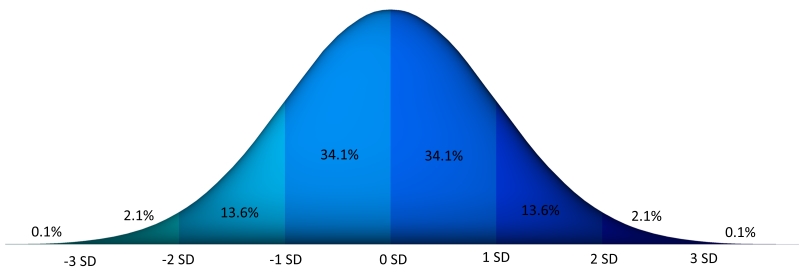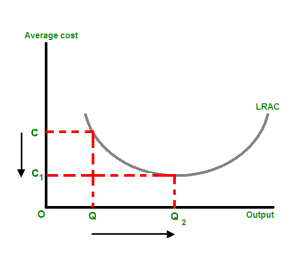At 6′7″, I’ve had a hard time with clothes, cars, and other manufactured objects. Other outliers such as short people and thin people share similar experiences. This is because of a rather bothersome mechanism known as the economy of scale. To explain this mechanism, let’s have a look at the apple business.
It is common knowledge that it is cheaper to buy apples by the bushel than the basket. But why is this the case?
Consider that the price of each apple is the sum of the costs from growing it right up until it ends up in your shopping bag. Some of these costs will be variable, meaning they are directly proportional to the number of apples sold. An example is water to grow the apples, which tends to be sold at a set rate no matter how much you use, within reason. You can see this on your water bill. If all costs were similarly variable, then the cost per apple would be independent of quantity.

Basket Of Apples by Kevin Phillips
However, there are also fixed costs. For example, land is required to grow the apples, a truck is required to drive the apples to the market, a booth is required to sell the apples, and employees must run the show. When these fixed costs are divided over a larger number of apples, the price per apple decreases. Furthermore, larger fixed costs are relatively cheaper. For instance, a larger plot of land will be cheaper per acre and similar can be said for the truck and the booth.
Sometimes the laws of scaling come into play, namely the square-cube law. Consider living accommodations. We all want single detached homes, but these can be pricey. A duplex is slightly cheaper for many reasons. One is heating costs are lower given the shared wall that is not exposed to the elements. Apartments are even better in this regard. In general, the larger the building the better as relative surface area decreases with size. Besides heating costs, there are many other scaling based sources for savings from construction materials to utility networks.
Larger scale also coincides with greater division of labor, and thereby specialization. And given our brains evolved to focus largely on one task at a time, this brings considerable benefit. Ironically, Adam Smith, the Scottish philosopher who may have first recognized the benefits of division of labor, likely wouldn’t have been studying economics in today’s academic environment where philosophers are more specialized and seldom study all knowledge.
The point I’m trying to make thus far is that greater quantity yields lower prices. This mechanism is commonly known as the economy of scale. It is because of this mechanism that larger quantities of apples are cheaper per apple, a benefit that is passed down to the consumer who buys larger quantities. Economies of scale such as these are what has led to production in ever greater volume by ever larger entities, as was foreseen by the German philosopher, Karl Marx1.
By now you may be wondering what this has to do with outliers such as tall people in the first place. Take a look at the curve in the graph below. It represents what is known as a normal distribution and is bell shaped. The peak of this bell coincides with average height, meaning there are a whole lot of average height people out there, while the sides of this bell represent the shortest and tallest of people, meaning there are far fewer of us. And because of this, as a group, we are purchasing in smaller quantities, quantities akin to the basket rather than bushel of apples, and so must pay more.
But often we aren’t willing to pay more. Hence companies simply neglect us and instead focus on the masses. This is why there are more goods produced per average size person than per person two standard deviations above average. This is manifested as the inconveniences we face including ill-fitting clothing.
Worse though, yet still due to this same lack of economy, ergonomic hazards occur, as seen in work environments and transportation. Not even medical devices and procedures, as alarming as this may be, are exempt from this predicament. Even scientific research revolves around the average height person; while the repository of knowledge of the human being is rapidly expanding, knowledge of the variations due to tall stature remains obscure.
Entrepreneurs, tall ones in particular, are constantly recognizing the need for tall specific clothing and other products. However, some may not realize that it is not because few have perceived it that this need exists. Rather, it is because this need is expensive to address. Nevertheless, there are niche companies out there that are geared towards tall consumers. These of course are typically online businesses, avoiding the fixed costs of a brick-and-mortar business. Other aspects of a business that suffer from a lack of scale do still present challenges, including software licenses, liability insurance, any outsourced work, building rent, etc. Exacerbating the problem is the consumer’s lack of knowledge as to these concepts, and thereby a lack of understanding as to why a tall specific product or service must carry an increased price tag, have fewer options, or be of lesser quality. An example of the consequence of this is that tall women tend to choose style over fit2.
Economy does not increase indefinitely with volume of goods produced. Similar to how evolutionary forces lead to optimal animal size, there are also factors that lead to optimal operation size. In the example of the apple business, bottlenecks in the supply chain, such as a shortage of workers or pesticides, will actually decrease economy with scale. This is known as diseconomy of scale, and when combined with economy of scale, forms a U-shaped curve. Unfortunately for us, the apex of this curve tends to coincide with far greater quantities than we require.
However, there is another phenomenon that can become a factor, and that is disruptive technologies and paradigm shifts. These, like the environmental changes that can drive rapid evolution and even trigger speciation, can have a sudden impact on a business. Two such advancements that will be helpful to tall people are mass customization and on-demand manufacturing, which will be discussed in a later article.
-
Marx K. Capital: Volume One. Karl Marx Sel Writings. 1977;1; 1(1999).
-
Jones MR, Giddings VL. Tall women’s satisfaction with the fit and style of tall women’s clothing. J Fash Mark Manag An Int J. 2010;14(1).




David Folch
Thanks Jesse! And Sam for the well thought explanation. Spot on! 🙂
Thanks for reading David! I figure it will make a good building block for future posts.
This is a very touchy subject for us small entrepreneurs bringing special goods to the tall community. Some of us feel that we are overpriced. But your article do a great job explaining why a tall specific hand fabricated in the USA product will always be more expensive than a mass produced overseas one, that is not even getting the tall special R&D love that we put in it. 🙂
David Folch I forget if I sent you a copy of my book or not, this is actually a section from it. After it, I get into how another industrial revolution could change matters (on demand manufacturing, mass customization, etc.). Would you like the latest copy?
Yes you sent it to me thanks! I’ll look into this next section! 🙂
Hey there, I just had a conversation with my doctor about the health perspectives of tall people. I am 6’8 ” and as her husband is 6’9” she knows the subject also by personal experience. What she told me is that as many of us tall guys will have a significantly shorter lifespan, we will be likely to have financial difficulties in our final years because the pension system is made for people who on average live around 15 years longer while many of us giants have to quit work for health reasons around the age of 60. That’s another matter of being outliers in terms of time…
I have recently heard many commercials for The Squatty Potty! I laugh and say to me most commodes
Thanks for the great read. I’m looking into on demand manufacturing as I for one am super tired of wearing clothes that don’t fit my body. Bravo!
Glad you liked it, should be fascinating times ahead!
While I have shrunk with age at 6’10 this was always an issue, but I found it has more to do with attitudes than economics.
I had a very well paying job in my 20’s and would challenge this frequently, for example, when Levis had a manufacturing facility in our city, I called up and asked how much it would cost to have a pair of jeans made with an extra 4″ on the inside leg. Only to be told they didn’t do it.
I advised them that I wasn’t asking if they did that, but how much it would cost to do it…I offered a $1000 cash when Jean’s were $80 and they wouldn’t have a bar of it. I know damn well if I had approached one of their floor staff they would probably have done it for an extra $100
I have had the same issues with Shoes where several times I have been told they only bring in 2 pairs of 13’s because they aren’t the most common size and they mostly by 6-9s.
Pointing out that they sell out of the 13s in the first month and always have to sale off the left over 7s at the end of the season, that I was also evidence of there being greater demand and that there may be a greater demand due to the inverse square law that puts exponentially more pressure on shoes may be a factor…. This was talking to the owner / buyer of this store… But they just couldn’t get their head around it ha ha.
Like all the times I have been told how lucky I am to be so tall by people at the check-in counter only to be told there are no seats I can fit in etc.